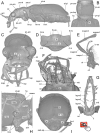MicroCT data provide evidence correcting the previous misidentification of an Eocene amber beetle (Coleoptera, Cicindelidae) as an extant species
- PMID: 37679371
- PMCID: PMC10484930
- DOI: 10.1038/s41598-023-39158-7
MicroCT data provide evidence correcting the previous misidentification of an Eocene amber beetle (Coleoptera, Cicindelidae) as an extant species
Abstract
The fossil record suggests some insect species have a marked longevity. The oldest fossils purported to represent extant insect species are from the Oligocene and Eocene. One of the most cited fossils is the extant tiger beetle Tetracha carolina (Coleoptera: Cicindelidae) that was identified over a century ago by Walther Horn in Eocene Baltic amber. We examined this and compared it to the previously described cincindelid Baltic amber fossil Palaeoiresina cassolai using X-ray microscopy and 3D imaging techniques. We conclude that Horn's fossil tiger beetle specimen is conspecific with the Eocene P. cassolai and is a member of an extinct stem group lineage of Cicindelidae. Based on a review of all the tiger beetle fossils described from Cretaceous and Paleogene deposits, we found that the assignment of these fossil species to extant lineages is not supported. There are currently no synapomorphies known from fossils that can provide evidence for Cretaceous Manticorni or Megacephalini nor is there evidence for Eocene Iresina. We provide evidence that rejects the idea of a recent beetle species persisting since the Eocene period, which is crucial for using the currently known fossil Cicindelidae species to calibrate divergence dating of beetle phylogenies.
© 2023. Springer Nature Limited.
Conflict of interest statement
The authors declare no competing interests.
Figures




References
-
- Stanley SM. Rates of evolution. Paleobiology. 1985;11:13–26. doi: 10.1017/s0094837300011362. - DOI
-
- Schweigert G. Alpenbock und Hirschkäfer im Pliozän von Willershausen. Fossilien. 2003;20:178–182.
-
- Elias SA. Advances in quaternary entomology. Dev. Quat. Sci. 2010;12:1–288.
-
- Hörnschemeyer T, Wedmann S, Poinar G. How long can insect species exist? Evidence from extant and fossil Micromalthus beetles (Insecta: Coleoptera) Zool. J. Linn. Soc. 2009;158:300–311. doi: 10.1111/j.1096-3642.2009.00549.x. - DOI

